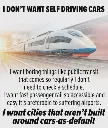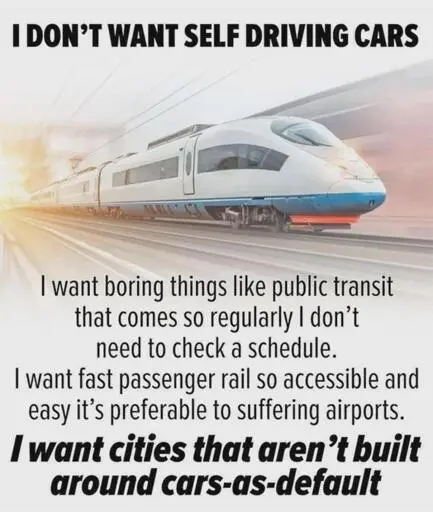The dream
The dream


The dream


You're viewing a single thread.
I want a better distribution of walkable white collar work and more work-from-home jobs.
I used to live within easy walking distance to the light rail, and work was easy walking distance from the other stop. The stops were 20 miles apart through the center of the city.
I could drive there, around the beltway, around the whole damn west side in 30 minutes.
The train was over an hour on a good day.
I tried it:
Day one, there was some mid day stuff happening in town, the train was PACKED and spent 10m at every stop, that day was 2 hours.
Had a few decent days, then they hit a car. We were forced to stay on the train for an hour in summer heat, no AC.
Some days the train was every 10. Some days every 30, some days 2 in a row. It was supposed to change frequency with time, it changed rather randomly.
By the end of my first month, there was an outage, so they did a bus bridge. That trip home was 4 hours.
I know that the light rail here was just substandard. but that didn't make it any easier.
Trains need a specific ecosystem and population density to thrive. In the US, we seem to have an issue that installing train stops connecting suburbs to significant cities brings crime to the suburbs and pushes out boutique shops from the stops. Is there any of that in other countries, or does the train increase commerce in an area?
my town has the worst god damn trains, i swear to fuck they're not even trying
Anyway:
trains need a specific ecosystem and population density to thrive
Which is totally not just some unverified just-so story people fucking say because it sounds nice, in spite of all evidence.
do trains work to connect a population of 4,000 540 miles away to a 300,000 person city?
It sounds like your city does not prioritize trains at all
train was PACKED and spent 10m at every stop
add more wagons or increase frequency for example
then they hit a car
intersections with car traffic are always a problem and they should be minimized
train was every 10. Some days every 30, some days 2 in a row
i can bet the tracks share the same space with regular roads and signaling does not prioritize public transit, which usually leads to this sort of inconsistent schedule
that didn’t make it any easier
that's usually the excuse used to cut funding to public transit instead of the other way around: "see it doesnt work, why waste money on it". They never mention how it's been underfunded for decades, how cars are always prioritized, and the success cases seen all around the world where it works properly
does the train increase commerce in an area?
stations are usually prime real state for commerce and housing due to all the foot traffic it brings. Just look at stations in Japan, they are basically big shopping malls, without all the unnecessary parking, and high towers all around for housing